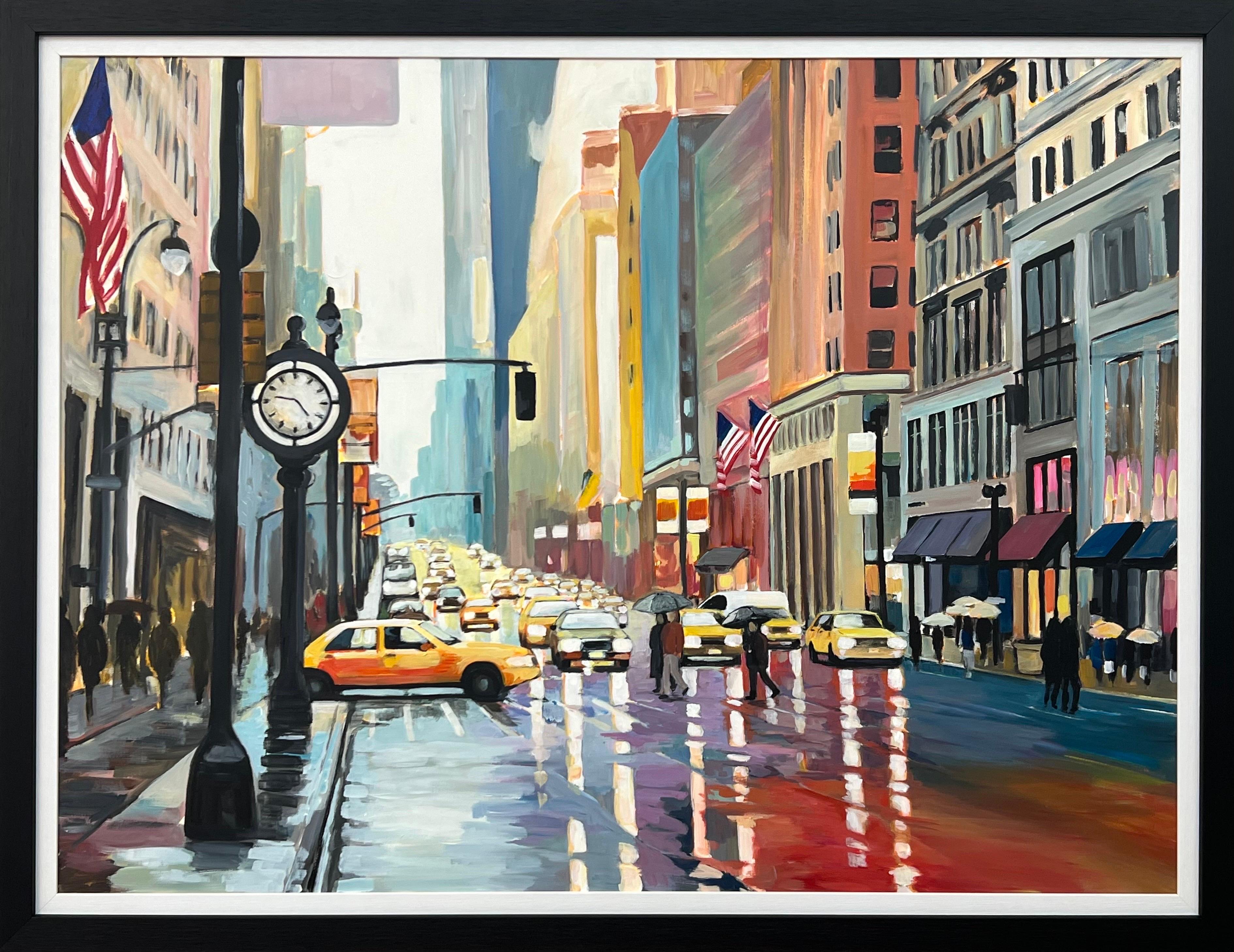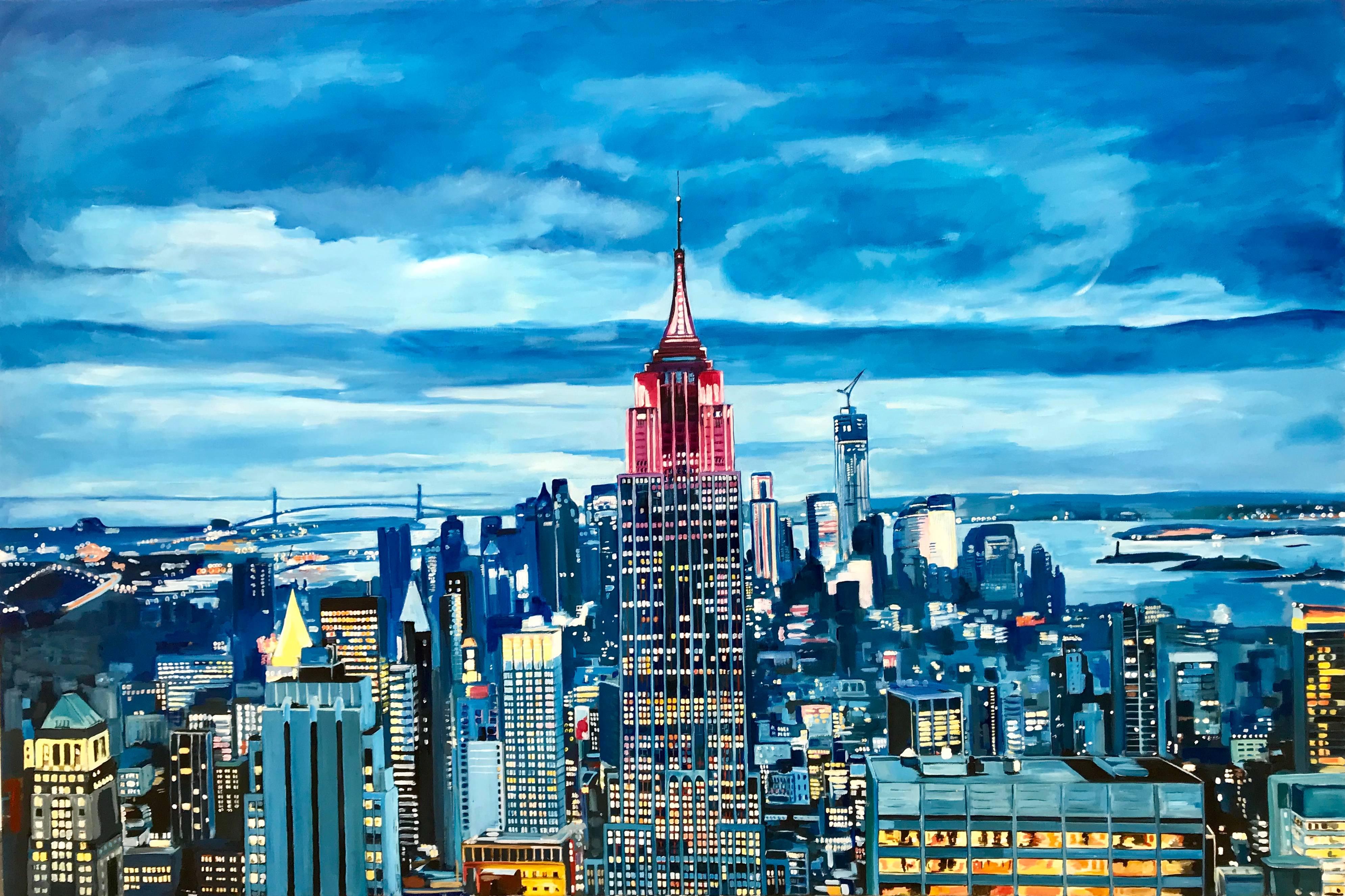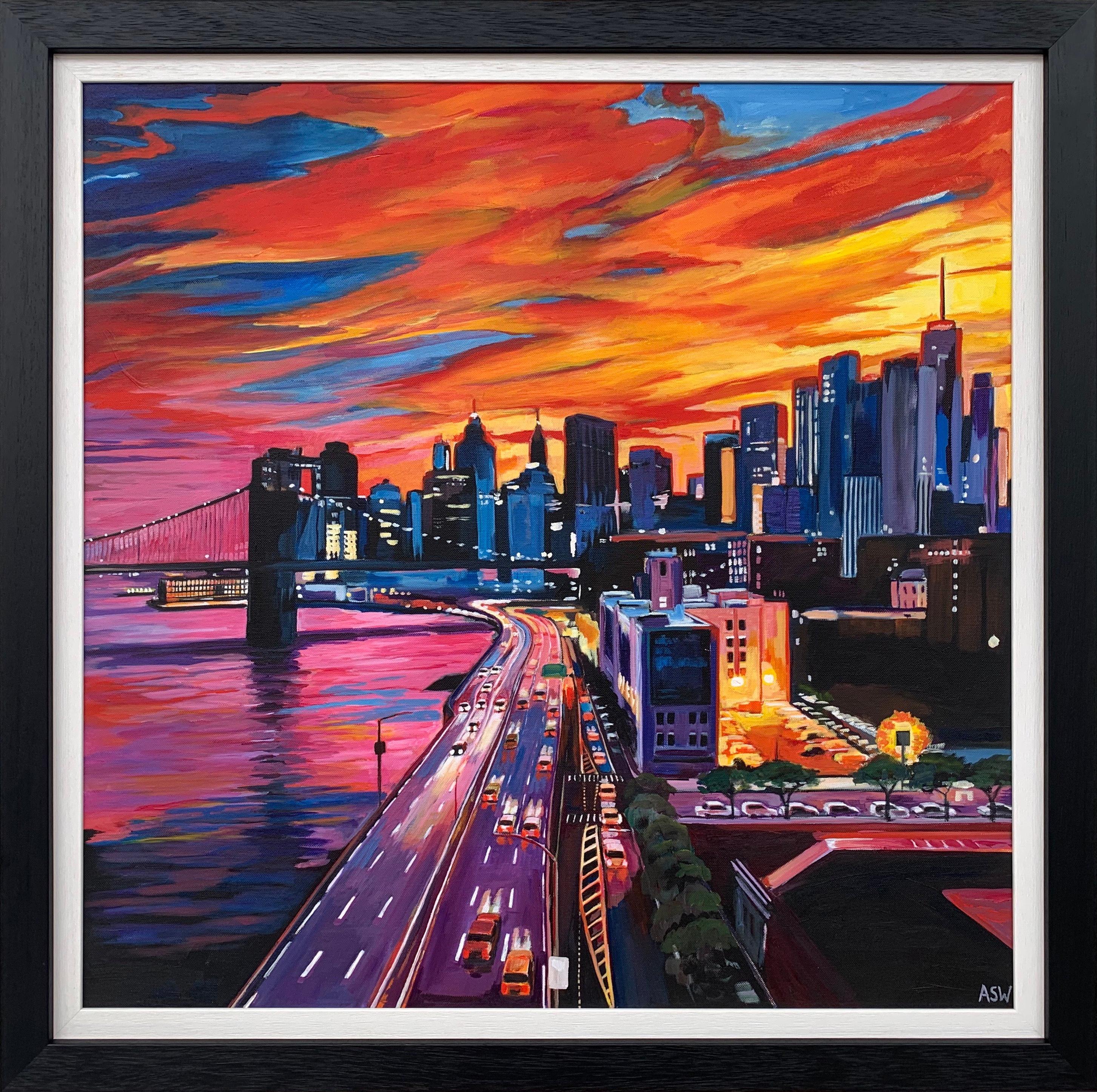New York Painting: A Canvas Of Urban Artistry & History
New York painting stands as a monumental testament to the city's unparalleled role as a global epicenter of art and culture. From the gritty realism of early 20th-century urban scenes to the groundbreaking abstract movements that redefined modern art, the canvas of New York has always mirrored the dynamic pulse of its streets and the boundless ambition of its inhabitants. It's a story of innovation, rebellion, and profound artistic expression, deeply intertwined with the very fabric of the city itself.
For centuries, artists have flocked to New York, drawn by its vibrant energy, diverse communities, and the promise of creative freedom. This influx has fostered a unique artistic ecosystem, giving birth to movements that reverberated across the globe and leaving an indelible mark on the history of art. This article delves into the rich tapestry of New York painting, exploring its origins, its transformative periods, and its enduring legacy, inviting you to discover why the art born from this metropolis continues to captivate and inspire.
Table of Contents
- The City as Muse: Early Influences on New York Painting
- The Dawn of Modernism: New York's Artistic Revolution
- Abstract Expressionism: New York Painting's Global Ascent
- Pop Art and Beyond: Challenging Conventions in New York Painting
- Graffiti and Street Art: The Urban Canvas of New York Painting
- Contemporary New York Painting: Diversity and Innovation
- Iconic Institutions: Preserving and Promoting New York Painting
- The Economic and Cultural Impact of New York Painting
The City as Muse: Early Influences on New York Painting
Long before it became the undisputed capital of the art world, New York City was already inspiring artists with its burgeoning urban landscape and diverse populace. In the late 19th and early 20th centuries, a significant shift occurred in American art, moving away from idealized landscapes and academic portraiture towards a more direct engagement with contemporary life. This era laid the groundwork for what would become characteristic of **New York painting**: a raw, unvarnished depiction of reality.
The Ashcan School, a collective of artists active in the early 1900s, perfectly embodied this spirit. Led by figures like Robert Henri, George Bellows, and John Sloan, these artists rejected the genteel subjects favored by the National Academy of Design, choosing instead to portray the gritty, everyday scenes of New York City. Their canvases teemed with images of tenements, bustling streets, boxing matches, and working-class life. They captured the energy of the city's immigrants, the vibrancy of its entertainment, and the stark realities of its social stratification. Their bold brushstrokes and often dark palettes reflected the urban environment, making the city itself a central character in their works. This commitment to realism and the portrayal of modern urban life was a foundational element, setting the stage for future generations of artists who would continue to find endless inspiration in the city's unique character.
The Dawn of Modernism: New York's Artistic Revolution
The early 20th century marked a pivotal moment for **New York painting** as the city began to truly embrace modernism. The catalyst for this transformation was undoubtedly the 1913 Armory Show, officially known as the "International Exhibition of Modern Art." Held in New York City, this groundbreaking exhibition introduced American audiences to European avant-garde movements like Cubism, Fauvism, and Futurism, shocking and exhilarating viewers in equal measure. It was a seismic event that shattered traditional artistic conventions and opened the floodgates for experimentation.
While initially met with controversy, the Armory Show irrevocably altered the trajectory of American art. Artists like Alfred Stieglitz, through his influential gallery 291, championed European modernists and fostered a dialogue between American and European art. American artists, previously somewhat isolated, now had direct exposure to revolutionary ideas about form, color, and abstraction. This period saw the emergence of American modernists like Marsden Hartley and Georgia O'Keeffe, who, while often inspired by the American landscape, also absorbed the lessons of European abstraction. The city became a crucible where these new ideas were debated, adapted, and eventually transformed into distinctly American expressions, setting the stage for New York to become a global artistic hub rather than just a recipient of European trends.
Abstract Expressionism: New York Painting's Global Ascent
The mid-20th century witnessed the unparalleled rise of Abstract Expressionism, a movement that not only redefined **New York painting** but also firmly established New York City as the new center of the art world, eclipsing Paris. Emerging in the aftermath of World War II, this movement was characterized by large-scale, non-representational canvases that emphasized spontaneous, energetic, and often gestural application of paint. It was a deeply personal and emotional form of expression, reflecting the anxieties and hopes of a post-war generation.
The "New York School," as it came to be known, included towering figures whose individual styles, while distinct, shared a common thread of pushing the boundaries of traditional painting. Artists like Jackson Pollock, Mark Rothko, Willem de Kooning, and Franz Kline became household names, their works commanding attention and sparking intense debate. They rejected conventional composition and subject matter, instead focusing on the process of creation itself, the physicality of paint, and the direct communication of emotion through color and form. Their monumental works, often created in the vast lofts of downtown Manhattan, became symbols of American artistic prowess and innovation, cementing New York's reputation as the birthplace of truly revolutionary art.
Jackson Pollock and Action Painting
Perhaps no artist is more synonymous with Abstract Expressionism than Jackson Pollock. His revolutionary "drip" technique, where he poured, dripped, and flung paint onto canvases laid on the floor, earned him the moniker "Jack the Dripper" and fundamentally altered the understanding of painting. This method, often referred to as "Action Painting," was not merely about applying paint but about the physical act of creation itself. Pollock's entire body was involved in the process, making the canvas an arena for his movements and gestures.
His large-scale works, such as "Autumn Rhythm (Number 30)" (1950) or "Lavender Mist" (1950), are intricate webs of intertwined lines and colors, lacking a central focal point but possessing an overwhelming sense of energy and depth. They invited viewers to immerse themselves in the visual experience, to trace the chaotic yet controlled paths of paint, and to feel the raw emotion embedded within each stroke. Pollock's radical approach challenged the very definition of a painting, moving it from a window onto a scene to an object of direct experience, profoundly influencing subsequent generations of artists and solidifying his place as a titan of **New York painting**.
Mark Rothko and Color Field Painting
In stark contrast to Pollock's dynamic action, Mark Rothko pioneered a different facet of Abstract Expressionism known as Color Field Painting. Rothko's works are characterized by large, soft-edged rectangular forms of color, often stacked one above the other, that seem to float on the canvas. These paintings are not about narrative or representation but about evoking profound emotional and spiritual experiences through the subtle interplay of color, light, and space.
Rothko meticulously layered thin washes of paint, creating luminous surfaces that appear to glow from within. He intended his works to be viewed up close, allowing the viewer to be enveloped by the vast expanses of color, fostering a meditative or even transcendental experience. Pieces like "No. 14, 1960" or "Orange and Yellow" (1956) exemplify his mastery of color's psychological impact. Rothko believed that art should convey "basic human emotions – tragedy, ecstasy, doom." His contributions broadened the scope of **New York painting**, demonstrating that abstraction could be a vehicle for deep introspection and universal feeling, proving that the city's artistic output was as diverse as it was groundbreaking.
Pop Art and Beyond: Challenging Conventions in New York Painting
As the fervor of Abstract Expressionism began to wane in the late 1950s and early 1960s, a new, provocative movement emerged from the streets and studios of New York City: Pop Art. This movement represented a decisive break from the introspective and often angst-ridden canvases of the Abstract Expressionists. Pop Art embraced the mundane, the commercial, and the mass-produced imagery of popular culture, bringing it directly into the realm of fine art. It was a witty, often ironic, and undeniably American response to the consumer-driven society of the post-war era, further diversifying the landscape of **New York painting**.
Artists like Andy Warhol, Roy Lichtenstein, James Rosenquist, and Claes Oldenburg took inspiration from advertisements, comic books, product packaging, and celebrity culture. They challenged the traditional notions of artistic subject matter and technique, often employing mechanical reproduction methods like silkscreen printing to mimic the impersonal nature of mass media. This shift marked a significant cultural moment, reflecting a society increasingly saturated with images and products. Pop Art was not just about what was painted, but how it was presented and perceived, making the viewer question the boundaries between high art and everyday life.
Andy Warhol's Pop Art Legacy
No discussion of Pop Art in New York would be complete without acknowledging the colossal impact of Andy Warhol. Warhol was not just an artist; he was a cultural phenomenon, a master of self-promotion, and a shrewd observer of American society. His iconic works, such as the "Campbell's Soup Cans" (1962), "Marilyn Diptych" (1962), and "Coca-Cola" bottles, elevated everyday objects and celebrity portraits to the status of high art.
Warhol's use of silkscreen printing allowed for the repetition and mass production of images, blurring the lines between art, commerce, and celebrity. His studio, "The Factory," became a legendary hub for artists, musicians, writers, and socialites, embodying the vibrant, experimental spirit of 1960s New York. Warhol's work reflected on themes of consumerism, fame, death, and the mechanical reproduction of images, profoundly influencing not only **New York painting** but also fashion, music, and performance art. His legacy continues to resonate, demonstrating the power of art to both reflect and shape culture, proving that the city's artistic output was as diverse as it was groundbreaking.
Graffiti and Street Art: The Urban Canvas of New York Painting
Beyond the galleries and museums, a vibrant and often rebellious form of **New York painting** emerged directly from the city's streets: graffiti and street art. Beginning in the late 1960s and flourishing throughout the 1970s and 80s, this movement transformed subway cars, building walls, and public spaces into canvases for raw, unfiltered artistic expression. It was a grassroots phenomenon, born from urban youth culture, and initially dismissed by the art establishment as vandalism, yet it would eventually gain global recognition and influence.
Early graffiti artists, known as "writers," focused on elaborate tagging and lettering, developing complex styles and rivalries. As the movement evolved, it incorporated more imagery, characters, and intricate compositions, moving towards what is now recognized as street art. This art form was inherently ephemeral, subject to removal or painting over, yet its impact was profound. It gave voice to marginalized communities, challenged authority, and democratized art by making it accessible to everyone, everywhere. Figures like Jean-Michel Basquiat and Keith Haring, who began their careers in the graffiti scene, successfully transitioned into the mainstream art world, bringing the energy and immediacy of the streets into galleries and museums, further enriching the diverse tapestry of **New York painting**.
The Evolution of Street Art in NYC
The evolution of street art in New York City is a fascinating narrative of artistic innovation and cultural adaptation. What began as simple tags on subway cars, primarily focused on gaining notoriety within specific crews, quickly developed into highly sophisticated forms. Artists started experimenting with wildstyle lettering, intricate designs, and the integration of characters, pushing the boundaries of what could be achieved with spray paint. The Bronx, Brooklyn, and Queens became open-air galleries, showcasing a dynamic and ever-changing display of urban artistry.
By the 1980s, the movement gained significant traction, with artists like Keith Haring using public spaces to create bold, graphic works that often carried social messages, addressing topics like AIDS awareness and anti-apartheid. Jean-Michel Basquiat, initially known for his "SAMO" tags, evolved into a powerful painter whose raw, neo-expressionist works fused street art aesthetics with art historical references, commenting on race, class, and identity. These artists, along with countless others, demonstrated that the streets of New York were not just a backdrop for life, but a fertile ground for genuine artistic genius. Today, street art continues to thrive in New York, with new generations of artists finding creative ways to engage with the urban environment, ensuring that this vibrant aspect of **New York painting** remains a powerful and evolving force.
Contemporary New York Painting: Diversity and Innovation
In the 21st century, **New York painting** continues its tradition of diversity and innovation, reflecting the city's ever-evolving global character. While no single dominant movement defines the current landscape, the art scene is characterized by a rich pluralism of styles, mediums, and conceptual approaches. Artists in New York today draw from a vast reservoir of art history, global influences, and contemporary societal issues, creating works that are as varied as the city itself.
Emerging artists are exploring new frontiers, often blending traditional painting techniques with digital media, performance, and installation art. Themes range from identity politics, environmental concerns, and technological impact to renewed interest in figuration, abstraction, and the materiality of paint. Galleries in neighborhoods like Chelsea, the Lower East Side, and Bushwick showcase a constant flow of new talent and established masters. The influence of global art markets and the increasing interconnectedness of the art world mean that New York remains a crucial hub for artistic exchange, where ideas from every corner of the globe converge and find new expression on canvas. This ongoing dynamism ensures that the story of **New York painting** is far from over, constantly reinventing itself while honoring its rich past.
Iconic Institutions: Preserving and Promoting New York Painting
The unparalleled legacy of **New York painting** is not solely built on the artists themselves but also on the formidable network of institutions that have nurtured, exhibited, and preserved this artistic heritage. New York City is home to some of the world's most prestigious art museums and galleries, each playing a crucial role in shaping the narrative and public perception of art created in and around the city.
The Museum of Modern Art (MoMA) stands as a beacon for modern and contemporary art, boasting an unparalleled collection of Abstract Expressionist and Pop Art masterpieces that were born in New York. Its galleries offer a chronological journey through the city's artistic revolutions. The Metropolitan Museum of Art, while global in scope, houses significant American art collections, including works from the Ashcan School and early American modernists. The Solomon R. Guggenheim Museum, with its iconic Frank Lloyd Wright architecture, often features groundbreaking exhibitions that push the boundaries of artistic presentation. The Whitney Museum of American Art, specifically dedicated to American art, provides a vital platform for showcasing the full breadth of American creativity, with a particular emphasis on works by New York-based artists. These institutions, alongside countless smaller galleries, artist-run spaces, and academic programs, form the backbone of New York's art ecosystem, ensuring that the history and future of **New York painting** remain vibrant and accessible to millions.
The Economic and Cultural Impact of New York Painting
Beyond its artistic significance, **New York painting** has had a profound economic and cultural impact, both locally and globally. The city's art market is one of the largest and most influential in the world, with major auction houses like Sotheby's and Christie's regularly setting new records for works by New York artists. This robust market attracts collectors, investors, and art enthusiasts from across the globe, contributing significantly to the city's economy through sales, tourism, and related industries.
Culturally, New York painting has shaped the city's identity, making it synonymous with artistic innovation and creative freedom. The presence of world-class museums and galleries, combined with a thriving contemporary art scene, makes New York a magnet for artists, students, and tourists. Art tourism is a major industry, drawing millions of visitors annually who come to experience the city's cultural offerings firsthand. Furthermore, the narratives embedded in New York painting – tales of urban life, social change, and individual expression – resonate deeply with audiences worldwide, influencing global art trends and inspiring new generations of artists. The ongoing dialogue between the city and its artists ensures that New York remains not just a place where art is made, but a place where art truly lives and breathes, continually redefining what painting can be.
Conclusion
The journey through the history of **New York painting** is a captivating exploration of artistic evolution, cultural shifts, and the enduring power of a city to inspire boundless creativity. From the gritty realism of the Ashcan School to the revolutionary strokes of Abstract Expressionism, the vibrant pop of Warhol, and the raw energy of street art, New York has consistently served as a canvas for the avant-garde, a crucible where artistic boundaries are shattered and new movements are born. It's a testament to the city's unique ability to foster innovation, attract diverse talents, and provide the fertile ground necessary for art to flourish.
The legacy of New York painting is not merely confined to museum walls; it permeates the city's very essence, visible in its architecture, its energy, and its unwavering spirit of reinvention. It reminds us that art is not static but a living, breathing reflection of its time and place. We encourage you to delve deeper into this rich history. Visit the iconic museums, explore the contemporary galleries, or simply walk the streets and imagine the countless masterpieces that have been conceived within this extraordinary metropolis. What aspect of New York painting resonates most with you? Share your thoughts in the comments below, or consider exploring more articles on our site about the intersection of art and urban life.

Angela Wakefield - Original Painting of New York City Chrysler Building

Angela Wakefield - Empire State Manhattan Cityscape Painting New York

Angela Wakefield - Empire State Building Sunset New York Cityscape NYC